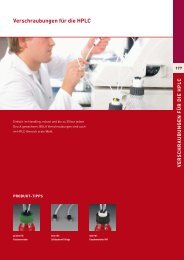You also want an ePaper? Increase the reach of your titles
YUMPU automatically turns print PDFs into web optimized ePapers that Google loves.
Chemical resistance of materialsSubstance groups + 20°C PE PP PBT PTFE ETFE VMQ NR FKM N.K.Alcohols ++ ++ ++ ++ ++ + + – +Aldehydes + + ++ ++ ++ + + – +Alkaline solutions ++ ++ +/– ++ ++ – + – +Esters + + + ++ ++ – + – –Ethers – – + ++ ++ – – – +Aliphatic hydrocarbons – ++ ++/+ ++ ++ – – ++ –Aromatic hydrocarbons – + ++/+ ++ ++ – – ++ –Halogenated hydrocarbons – + + ++ ++ – – ++ –Ketones + + +/– ++ ++ – – ++ –Diluted or weak acids ++ ++ ++ ++ ++ – + ++ +Strong acids ++ ++ + ++ ++ – – ++ –Oxidizing acids – + – ++ ++ – – + –++ = very good resistance+ = good resistance– = low resistancePRINCIPLES OF USING LABORATORY GLASSware SIMAX1. CleaningThe laboratory glassware can be cleaned either manually or in a laboratory dish washer using usual cleaningand disinfecting agents. It is recommended to wash the glass before the first use.Laboratory glassware which came into contact with infectious substances should be cleaned and sterilizedwith hot air or steam. In this way, burning-on of impurities and damaging of glass by possibly adheredchemicals is prevented.A) Manual cleaning:a) Laboratory glassware should be wiped and washed with a cloth or a sponge using a cleaning solution.b) Do not use abrasive washing agents as they can scratch the glass.c) Avoid extended exposition to alkaline media at temperatures above 70 °C as printing can be destroyed.B) Washing in dish washers:Washing of laboratory glassware in dish washers is more considerate than manual cleaning. The glassgets into contact with a cleaning solution for a relatively short time only during the phase of rinsing whenthe solution is sprayed on the glass surface.• When inserting the glassware into a dish waster care should be taken to prevent mutual impacts.2. Safety instructions for user• Never expose the laboratory glassware to sudden changes in temperature. Prevent taking hot glasswareout of a drier and putting it on a cold or wet laboratory table. The warning is particularly applicable toa thick-walled glassware, such as suction flasks or desiccators.• Before each evacuation or pressure stress of glass flasks, make visual inspection of a faultless state (forheavy scratches, impacts, etc.). Damaged glass flasks must not be used for works under pressure orvacuum.• The laboratory glassware under pressure or vacuum should be handled with care (e.g. with suctionflasks, desiccators).• Do not expose the glassware to sudden changes in pressure.• To prevent developing stress in the glass do not heat up glass flasks under vacuum or pressure fromone side or with an open flame.• The laboratory glassware with flat bottom (e.g. Erlenmeyer flasks, flasks with flat bottom) should not beexposed to pressure stress.5




